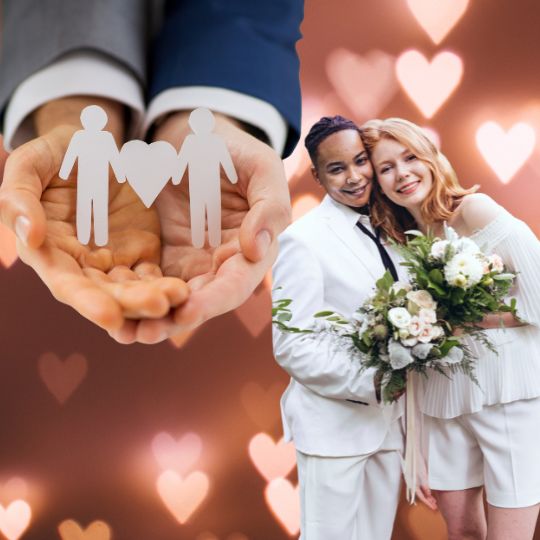Avoiding Gender Role
Stereotypes in your Wedding Ceremony
/08
by Jennifer
Cram - Brisbane Marriage Celebrant © 30 December
2024Categories: | Inclusive Weddings | Wedding Ceremony |
 While we are now on the cusp of a
quarter of the way through the 21st century, and
marriage equality has been legal for 7 years,
wedding ceremonies, regardless of gender mix of the
couple, still largely follow the blueprint for a
traditional hetero wedding.
While we are now on the cusp of a
quarter of the way through the 21st century, and
marriage equality has been legal for 7 years,
wedding ceremonies, regardless of gender mix of the
couple, still largely follow the blueprint for a
traditional hetero wedding.The content of this blog post was written many years ago and posted on my Pride Ceremonies® website.
The six reasons why weddings tend to follow the blueprint for a traditional hetero wedding continue to apply. As do the reasons why weddings do not have to stick with this blueprint, regardless of gender mix!
The six reasons
The
- When you’re not sure of what you can do, you tend to do what you think you should do, i.e. follow traditional wedding ‘etiquette’ even though in Australia same-sex weddings are not legal ceremonies (Spoiler Alert – a wedding is the big white fancy experience, it can result in a legal marriage if all the legal requirements are met, but it doesn’t have to, so any couple can have a wedding)
- Lack of an established set of traditions/etiquette for same-sex weddings means that both celebrants and same-sex couples continue to fall back on a highly gendered wedding script – everything from the choreography and wording of the ceremony to the ‘traditional’ components of the reception. Let’s face it, as a couple you don’t fit into this hetero norm – justification enough not to be sucked into it.
- “Everyone understands” the roles denoted by titles such as ‘bride’, ‘groom’, bridesmaid, groomsman, and also feminine and masculine forms of words. Maybe. But come on, people, your guests also have eyes! There is no need to go with awkward nods to the gendered roles of the traditional weddings by terms such as “bride and groomette”. Two grooms, two brides, and bridal party members called anything you like are all more than acceptable.
- A hetero wedding is just a wedding. A same sex wedding is also on some level a ‘coming out’. To emphasize the sincerity and depth of your commitment to one another I’m all for same sex couples using the traditional ‘for better, for worse’ vows, or variations thereof, becuase these are promises that most of us could almost recite in our sleep due to the way the symbolism of life-long union that they represent is ingrained in our cultural tradition. Set in a ceremony that avoids the other gender stereotypes your vows will stand out.
- A hetero wedding is a just wedding (take 2). A same sex wedding involves coming out to all of the wedding service providers you contact – not just the ones you book. At this stage you’re just stating the facts, not aping gendered roles to fit in with the traditional form of a hetero wedding. You’re the customer, so, if your service providers are comfortable* with you being a same sex couple you should feel no obligation to go along with any gendered “this is how it is done” assumptions or demands they might subsequently make. “That won’t work for us as a same-sex couple” is all you need to say.
- A processional is just that – a way of getting you up the front to start the ceremony. Traditionally it is seen as the way a bride is brought to her groom prior to being given to him by her father. Society in general has outgrown that notion. There is no need to adopt awkward gender roles in order to comply with an outdated tradition.
* Unfortunately, a small cohort of civil
celebrants (designated religious celebrants) is
allowed to discriminate on the basis of their
own beliefs. And we still hear reports of other
vendors who, while they may not disclose
the reason (it is unlawful discrimination, after
all), may give a different, plausible, reason to
avoid providing service to a same sex wedding.
Related Information
- Next-Gen: The ReImagined Wedding Ceremony
- Yes! You CAN have a gender-neutral, stereotype-free, wedding ceremony
- Jennifer Cram, The Inclusive Celebrant: My Commitment to Diversity and Inclusion
Thanks for reading!

pullin0 Things